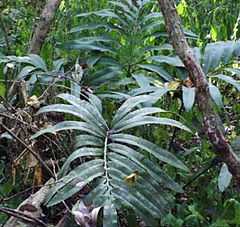Stangeriaceae
| Stangeriaceae | |
|---|---|
 | |
| Stangeria eriopus in coastal lowland forest, South Africa | |
| Scientific classification | |
| Kingdom: | Plantae |
| Division: | Cycadophyta |
| Class: | Cycadopsida |
| Order: | Cycadales |
| Family: | Stangeriaceae |
| Genera | |
Stangeriaceae is the smallest family of cycads, both in number of living and fossil species. The family contains only two living genera, Stangeria and Bowenia, though the latter genus has been recommended for placement in a separate family by itself.
The family is recognized by having vascularized stipules, and by lacking cataphylls, or producing them irregularly. These unusual characters led to the original description of Stangeria as a fern, and it was only when seeds were later produced on the plant that its true affinities were realized.[1]
Though today the family occurs only in South Africa and Queensland, Australia, fossils are known from Jurassic sediments in Argentina and the British Isles.[2] Recent cladistic studies suggest that the fossil taxon Mesodescolea may also have affinities with the Stangeriaceae. This highly lobed fossil leaf from the Lower Cretaceous has only been found in Argentina.
| Wikispecies has information related to: Stangeriaceae |
References
- ↑ "The Cycad Pages: Stangeria eriopus", Royal Botanic Gardens Sydney website
- ↑ Fossil record of the Cycads